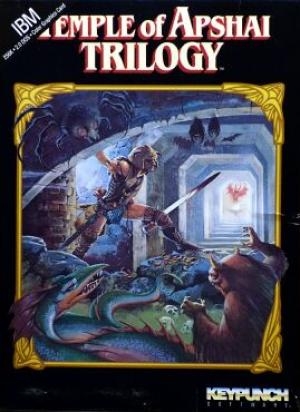
| Console: | PC |
| TV Standard: | Region Not Set |
| Developer(s): | Epyx |
| Publisher(s): | Epyx, Inc. |
| Release Date: | 1985-06-11 |
| Co-op: | No |
| Type: | Role-Playing |
The player in Temple of Apshai assumes the role of an adventurer who explores the mysterious ruins of the Temple of Apshai. This player character investigates room after room of this dungeon setting while seeking treasure and combatting monsters. Along the way, the player discovers powerful weapons and armor with which to overcome the Temple's inhabitants. The game consists of four dungeons with over 200 rooms in total and features 30 monster types.[5]
Temple of Apshai consists of two programs; the Innkeeper and the Dunjonmaster. The game starts with the Inkeeper and the choice to either generate a new character or input an existing one.[6] The game uses six base values taken from Dungeons & Dragons[7] Early tape versions of the game had no means to save progress, and thus the player was prompted to note down all statistics when quitting the game, and had to type them in again manually at the start of the next game.[1][8] Later floppy versions fixed this by allowing to save the status on the disk.[9] Weapons and armor are purchased in a shop, where it is possible to haggle with the shopkeeper for a discount. Character stats determine which items can be worn.[8] Finally, the player chooses between four dungeons of increasing difficulty to enter the Dunjonmaster part.[6]
In the Dunjonmaster program, the screen is divided into a birds-eye view representation of the surroundings and a status summary for the character. Traps, treasures and secret doors are hidden inside the dungeons.[8] Temple of Apshai uses a hybrid between a turn-based and a real time combat system. A player's turn can be used to walk up to 9 steps in the direction the character is facing, turning towards either direction, trying to talk the monster out of the fight, or executing a number of different attacks. A bow and arrows can be used to attack enemies from afar. If the player doesn't make any input for a while, the enemies continue to move and attack in set intervalls regardless.[8] All actions decrease the player character's fatigue rating, depending on stats and carrying weight. When this value sinks below zero, the character cannot act anymore before resting.[10] The player gains experience points while adventuring, which raise a number of hidden statistics.[11]
Temple of Apshai was the first computer role-playing game with room descriptions.[1] Detailed descriptions of all the rooms in the game's manual complement the sparse graphics and provide vital information. Pen-and-paper games like Dungeons & Dragons frequently make use of verbal depictions given by dungeon masters to suggest to players what is of interest in a setting. Similarly, in Temple of Apshai the player matches an on-screen room number to its entry in the manual that accompanies the game. One sample entry reads: "The aroma of vanilla makes the senses reel and the floor of the room is covered with the shiny stuff previously observed. Bones lie scattered across the floor and the clicking sound grows fainter from within. Gems stud the south wall."[12] A vanilla scent is used in the game to suggests the presence of Antmen, the dominant monster type in the temple.[13]
When beaten by a monster, the player character may be rescued by one of several non-player characters. Depending on the rescuer, a portion of the player's inventory is taken away as payment.[9]
The game has no particular goal other than fighting monsters, collecting treasure[1] and gaining experience points.[8]









